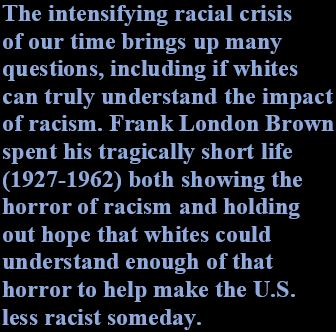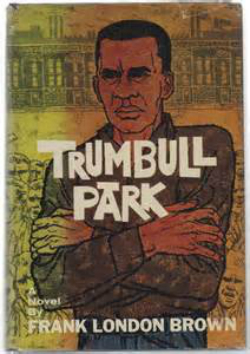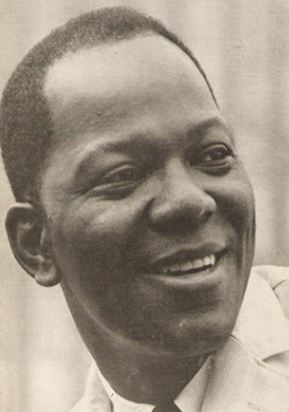Earlier in this tumultuous year I missed an in-person meeting called by Don Evans, president of the Chicago Literary Hall of Fame, to pick this year’s inductees. The final spot came down to two: Stanley Elkins and Frank London Brown. I emailed my vote in and Don sent this note to the rest of the committee at the end of March:
“Hi All — I just heard back from Richard. He casted the deciding vote for Frank London Brown. He wrote, ‘I vote for Frank London Brown. His ties to Chicago are much stronger. Trumbull Park is an important Chicago area story, and the short story “McDougal” a masterpiece touching on issues even more important today than when it was written. The intensifying racial crisis of our time brings up many questions, including if whites can truly understand the impact of racism. That’s a large part of what the story deals with…People might want to check [out my post on him] HERE…Stanley Elkins would be a good choice for another year.’”
Frank London Brown spent his tragically short life (1927-1962) both showing the horror of racism and holding out hope that whites could understand enough of that horror to help make the U.S. less racist someday. In the HERE link above, I focus more on that hope because I included “McDougal” in my book Black Writing from Chicago. But I also spend some time with Trumbull Park, his important novel dealing with the horror.
 The massive Encyclopedia of Chicago includes this entry on Trumbull Park: “South Deering erupted in violence in 1953 over the issue of racial integration at the neighborhood’s lone public housing project, Trumbull Park Homes, located at 105th Street and Yates Avenue. Since 1937, the Chicago Housing Authority (CHA) had maintained an unstated policy to house only whites at projects that, like Trumbull Park, were located in entirely white neighborhoods. However, the project was ‘accidentally’ integrated on July 30, 1953, because the CHA assumed that Betty Howard, an exceptionally fair-skinned African American, was white. Beginning on August 5 and continuing nightly for weeks thereafter, crowds of whites directed fireworks, rocks, and racial epithets toward Betty and Donald Howard’s apartment. Police responded with a show of force but few arrests. South Deering leaders openly pressured Chicago politicians and the CHA to remove the Howards, while progressive forces argued for further integration. In October, after lengthy debate, the CHA’s commissioners reluctantly agreed to move in 10 additional black families, triggering a new round of white violence directed at blacks. A massive police presence prevented full-scale rioting, but chronic racial tension and sporadic violence continued through the 1950s. Not until 1963 could African Americans openly use a neighboring public park without police protection. The conflict claimed the career of the CHA’s progressive executive director, Elizabeth Wood, who had pushed the CHA’s commissioners to further integrate the project. White violence had succeeded in blocking any further racial integration beyond the token black population in the project.”
The massive Encyclopedia of Chicago includes this entry on Trumbull Park: “South Deering erupted in violence in 1953 over the issue of racial integration at the neighborhood’s lone public housing project, Trumbull Park Homes, located at 105th Street and Yates Avenue. Since 1937, the Chicago Housing Authority (CHA) had maintained an unstated policy to house only whites at projects that, like Trumbull Park, were located in entirely white neighborhoods. However, the project was ‘accidentally’ integrated on July 30, 1953, because the CHA assumed that Betty Howard, an exceptionally fair-skinned African American, was white. Beginning on August 5 and continuing nightly for weeks thereafter, crowds of whites directed fireworks, rocks, and racial epithets toward Betty and Donald Howard’s apartment. Police responded with a show of force but few arrests. South Deering leaders openly pressured Chicago politicians and the CHA to remove the Howards, while progressive forces argued for further integration. In October, after lengthy debate, the CHA’s commissioners reluctantly agreed to move in 10 additional black families, triggering a new round of white violence directed at blacks. A massive police presence prevented full-scale rioting, but chronic racial tension and sporadic violence continued through the 1950s. Not until 1963 could African Americans openly use a neighboring public park without police protection. The conflict claimed the career of the CHA’s progressive executive director, Elizabeth Wood, who had pushed the CHA’s commissioners to further integrate the project. White violence had succeeded in blocking any further racial integration beyond the token black population in the project.”
In fact, as Kathleen Rooney reports, “Black residents had to sign police logs to enter and exit their homes, and had to commute into and out of Trumbull Park in a paddy wagon, accompanied by armed officers. The police played up the indignity and humiliation by treating them like criminals.” How does one persevere under those conditions? Can we truly feel enough of that pain from afar to keep us fiercely motivated to make our country less racist someday?
 Kathleen Rooney was part of that committee that met this past March to pick Chicago Literary Hall of Fame inductees, and recently published “How Trumbull Park Exposed the Brutal Legacy of Segregation,” for JSTOR Daily, an essential site for anyone interested in solid scholarly takes on a wide variety of issues illuminating today’s dilemmas. Of the novel itself she writes: “Often, books from the past, even the ones with the best intentions regarding social justice, fall short of what contemporary readers might hope. Feminist texts may be shot through with subtle racism, and anti-racist texts might be marbled with misogyny. But Brown’s approach is refreshingly intersectional, emphasizing the centrality of the Black women of Trumbull Park. Buggy [Buggy Martin, the reluctant, every-man hero of the book] complains of the motley crew of fellow Black residents they have as allies, and how fractious even that group can be. Helen looks at him seriously and says, ‘It’s too bad we can’t pick the people to help us fight, Buggy. But it always seems that the most likely ones never come through, and the least likely ones always do. What’ll we do—refuse help because it’s not from the right people?’”
Kathleen Rooney was part of that committee that met this past March to pick Chicago Literary Hall of Fame inductees, and recently published “How Trumbull Park Exposed the Brutal Legacy of Segregation,” for JSTOR Daily, an essential site for anyone interested in solid scholarly takes on a wide variety of issues illuminating today’s dilemmas. Of the novel itself she writes: “Often, books from the past, even the ones with the best intentions regarding social justice, fall short of what contemporary readers might hope. Feminist texts may be shot through with subtle racism, and anti-racist texts might be marbled with misogyny. But Brown’s approach is refreshingly intersectional, emphasizing the centrality of the Black women of Trumbull Park. Buggy [Buggy Martin, the reluctant, every-man hero of the book] complains of the motley crew of fellow Black residents they have as allies, and how fractious even that group can be. Helen looks at him seriously and says, ‘It’s too bad we can’t pick the people to help us fight, Buggy. But it always seems that the most likely ones never come through, and the least likely ones always do. What’ll we do—refuse help because it’s not from the right people?’”
Trumbull Park sold 25,000 copies upon publication and was praised by many, some mentioning it in the company of Lorraine Hansberry’s A Raisin in the Sun. Yet Kathleen Rooney had trouble getting any copy except a hard-to-find University Press edition. “Why aren’t more people reading this book?” she asks. “Even though it was effusively praised at the time of its 1959 publication by Gwendolyn Brooks and Langston Hughes, why does it not have the classic status it so richly deserves? Why, when it comes to the question of the great Chicago novel do we tend to hear the same set of names—Bellow, Algren, Sinclair—over and over with no mention of Brown?” She unearths some important reasons, but none as crucial as from Frank London Brown himself. Apparently, he felt he was writing more to a strictly black audience in a very specific way. He did not focus on black victimization, nor was he interested in appealing to or threatening a white audience. It all came down to the figure of Buggy Martin. “If I could get the Negro reader to identify himself with this man,” Brown said, “then, at the end of the novel, the reader would be sworn to courage—if the trick I tried to pull on Negro readers worked—”
Sworn to courage. Yes, Black Americans need this as they once again try to shoulder the burden of leading us into a better world. It will be a decades-long haul, though, so it will be a necessary thing for all of us of good and hopeful will to swear ourselves to courage as well.
♦ Fair housing and especially home ownership are the greatest drivers of this nation’s growing and dangerous wealth gap. See “The Racial Wealth Gap and Home Ownership,” and the work done to combat this by organizations like The Neighbor Project. The best introduction to The Neighbor Project’s work and vision is HERE, a recent speech given by executive director Rick Guzman.
♦ Go to a list of Black Writers on this site, most of whom are in my book Black Writing from Chicago. Most articles are much expanded versions of the introductions I wrote for the book.
